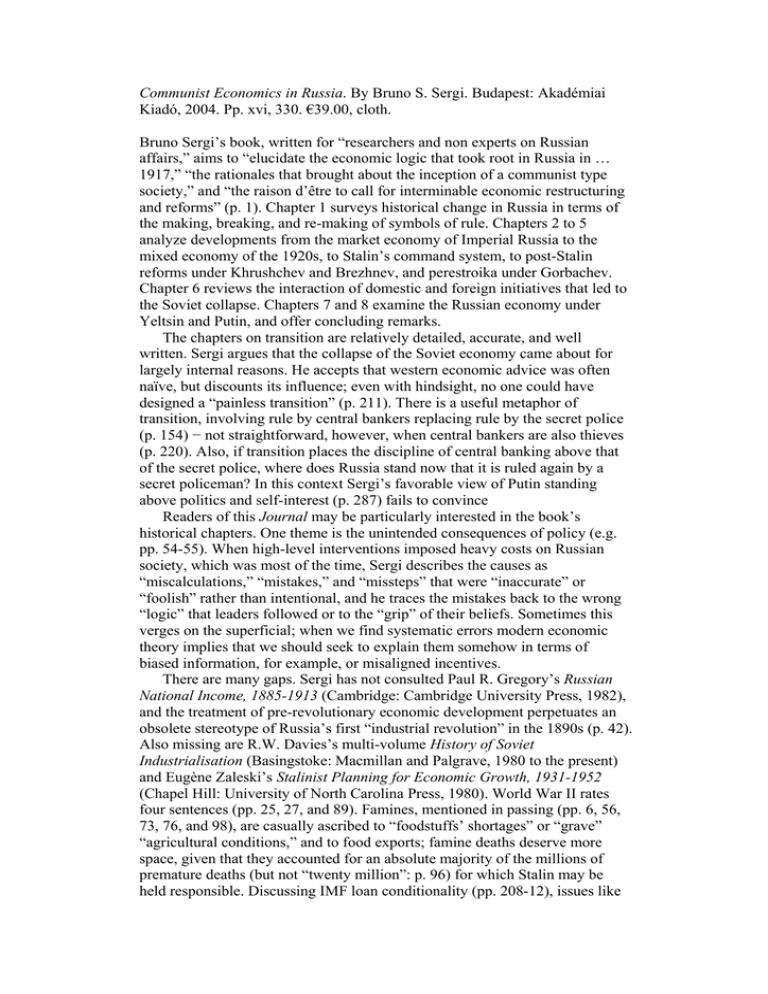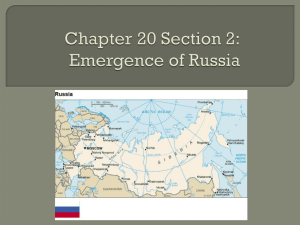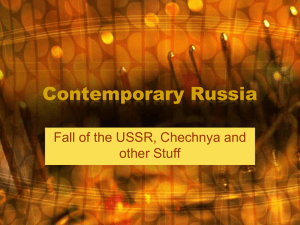Communist Economics in Russia Kiadó, 2004. Pp. xvi, 330. €39.00, cloth.
advertisement

Communist Economics in Russia. By Bruno S. Sergi. Budapest: Akadémiai Kiadó, 2004. Pp. xvi, 330. €39.00, cloth. Bruno Sergi’s book, written for “researchers and non experts on Russian affairs,” aims to “elucidate the economic logic that took root in Russia in … 1917,” “the rationales that brought about the inception of a communist type society,” and “the raison d’être to call for interminable economic restructuring and reforms” (p. 1). Chapter 1 surveys historical change in Russia in terms of the making, breaking, and re-making of symbols of rule. Chapters 2 to 5 analyze developments from the market economy of Imperial Russia to the mixed economy of the 1920s, to Stalin’s command system, to post-Stalin reforms under Khrushchev and Brezhnev, and perestroika under Gorbachev. Chapter 6 reviews the interaction of domestic and foreign initiatives that led to the Soviet collapse. Chapters 7 and 8 examine the Russian economy under Yeltsin and Putin, and offer concluding remarks. The chapters on transition are relatively detailed, accurate, and well written. Sergi argues that the collapse of the Soviet economy came about for largely internal reasons. He accepts that western economic advice was often naïve, but discounts its influence; even with hindsight, no one could have designed a “painless transition” (p. 211). There is a useful metaphor of transition, involving rule by central bankers replacing rule by the secret police (p. 154) − not straightforward, however, when central bankers are also thieves (p. 220). Also, if transition places the discipline of central banking above that of the secret police, where does Russia stand now that it is ruled again by a secret policeman? In this context Sergi’s favorable view of Putin standing above politics and self-interest (p. 287) fails to convince Readers of this Journal may be particularly interested in the book’s historical chapters. One theme is the unintended consequences of policy (e.g. pp. 54-55). When high-level interventions imposed heavy costs on Russian society, which was most of the time, Sergi describes the causes as “miscalculations,” “mistakes,” and “missteps” that were “inaccurate” or “foolish” rather than intentional, and he traces the mistakes back to the wrong “logic” that leaders followed or to the “grip” of their beliefs. Sometimes this verges on the superficial; when we find systematic errors modern economic theory implies that we should seek to explain them somehow in terms of biased information, for example, or misaligned incentives. There are many gaps. Sergi has not consulted Paul R. Gregory’s Russian National Income, 1885-1913 (Cambridge: Cambridge University Press, 1982), and the treatment of pre-revolutionary economic development perpetuates an obsolete stereotype of Russia’s first “industrial revolution” in the 1890s (p. 42). Also missing are R.W. Davies’s multi-volume History of Soviet Industrialisation (Basingstoke: Macmillan and Palgrave, 1980 to the present) and Eugène Zaleski’s Stalinist Planning for Economic Growth, 1931-1952 (Chapel Hill: University of North Carolina Press, 1980). World War II rates four sentences (pp. 25, 27, and 89). Famines, mentioned in passing (pp. 6, 56, 73, 76, and 98), are casually ascribed to “foodstuffs’ shortages” or “grave” “agricultural conditions,” and to food exports; famine deaths deserve more space, given that they accounted for an absolute majority of the millions of premature deaths (but not “twenty million”: p. 96) for which Stalin may be held responsible. Discussing IMF loan conditionality (pp. 208-12), issues like 2 domestic ownership and time consistency are flagged but not explained; the conditions themselves and the degree to which they were met are not discussed. Male life expectancy fell sharply between the late 1980s and early 1990s and this is used to illustrate the costs of transition (p. 251), but it is not acknowledged that mortality had been rising since the 1960s. If you recommend this book, your students will inevitably absorb and reproduce many errors of historical fact. Soviet labor camps were not unknown in the west before Alexander Solzhenitsyn’s Gulag Archipelago, 1918-1956 (New York: Harper & Row, 1974) (p. 29). The people’s commissars were not called sovnarkomi (p. 51). Stalin’s name is derived from the word for steel, not iron, and his other pseudonym was Koba, not Kobe (p. 60). Trotskii was exiled to Turkey in 1929, not to Britain in 1927, and so did not cause the 1927 rupture of Anglo-Soviet relations; Zinov’ev was not shot in 1927 nor Bukharin in 1929 (p. 61). More radical planners of the 1920s belonged to the “teleological,” not “theological” tendency (pp. 67-8). Gosplan neither “instructed, controlled and monitored all the vast state economic bureaucracy” nor “matched in physical terms all inputs for broad classes of products” (p. 69). The poorest peasants were the bedniaki, not the muzhiki; during collectivization 2½ million designated kulaki, or richer peasants, were imprisoned or else exiled to the remote interior, not moved to “industrial places” (p. 74). The execution of 800,000 came after, not in or before 1933 (pp. 75-6). The planning chief Voznesenskii was executed in 1949 because of political infighting, not because he favoured a more balanced plan (p. 95). The 1946/47 famine hardly “symbolized the general breaking down of the system” (p. 98). The labor-saving experiment at the Shchekino chemical plant in the 1960s was unrelated to the campaign for “chemicalization” of the economy (pp. 111-14, 323). The New Economic Mechanism was launched in 1968 but in Budapest, not Moscow (p. 119). The Soviet practice of khozraschet, or costaccounting, dates from the 1930s, not the 1960s (p. 327). In many places it is unclear what is being argued since the standard of English is so poor. To summarize, this book is a frustrating read. It is like joining the company of someone with the reputation of a clever and difficult thinker; you understand a little of what is being said, puzzle over some more, guess at the rest, blame yourself, and hope to catch up one day. In this case, it is not your fault; the author and publisher should have taken greater care. Mark Harrison University of Warwick







